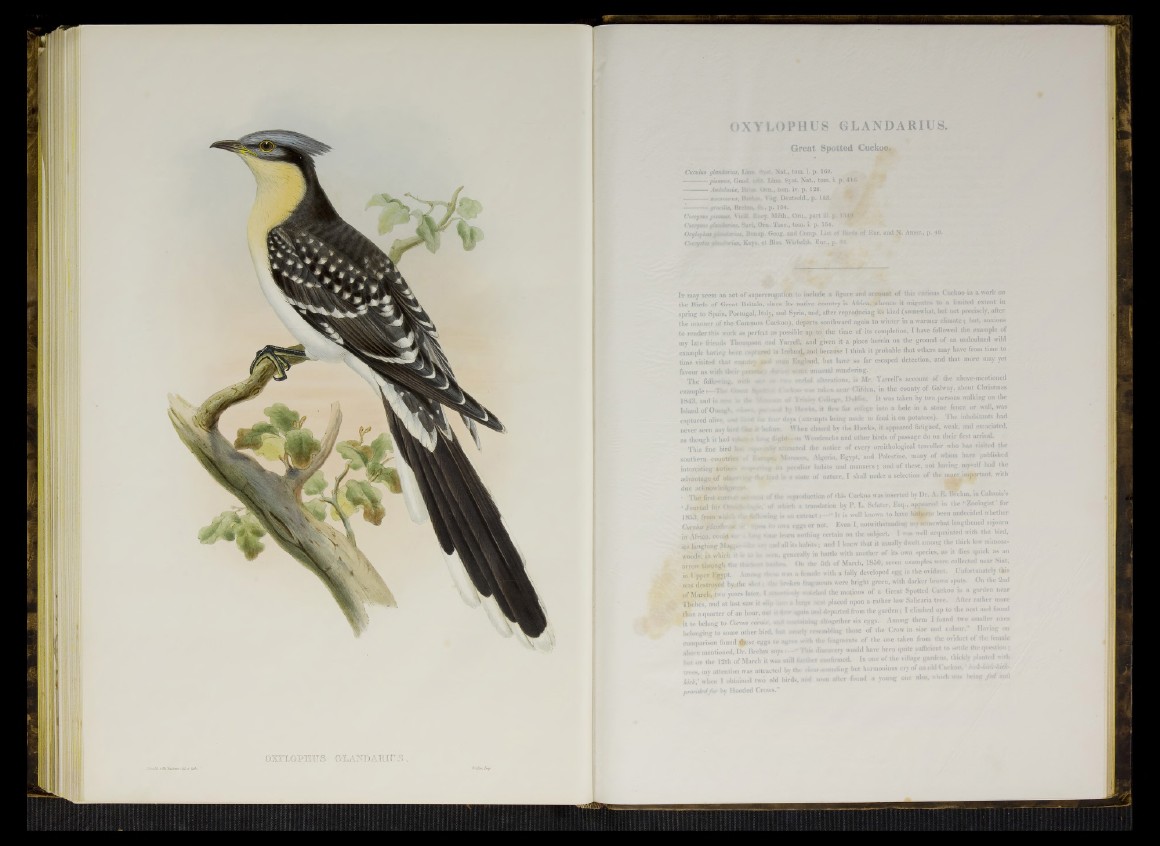
O X TM M tlT S G L A H D A B ItrS .
OXYLOPHUS GLANDARIUS.
Great Spotted Cuckoo.
Cticulus glandarius, Li»«. Ay si. Nat., tom. i. p. 169. . ;>r-
----------pisanvs, Ginel t&t- Lin». Syst. Nat., tom. i. p. 416.
■ Andalusia, Brist Ont., tom. iv. p. 126.
-----------mvcrwrut, Br >' \Vo g. DeutschL, p. 153.
-----------gracilis, Brebm. ib., p. 154.
Coccyxtu pisanvs. VieiB, Etiey. Meth., Orn., part Hi. p. 1349.
Coccgsvts jfnitrfarnm~. Sari, Orn. Tosc., tom. i. p. 154.
Oiajlophus Booap. Geog. and Comp. List of Bkd* of Eur. and N- Amer., p. 40.
Coccystsf gtmdarita, Keys, et Bias. Wirbelth. Eur., p. 34.
It may seem an act of supererogation to include a figure and account of this curious Cuckoo in a work on
the Birds of Great Britain, since its native country is Africa, whence it migrates to a limited extent in
spring to Spain, Portugal, Italy, and Syria, and, after reproducing its kind (somewhat, but not precisely, after
the manner of the Common Cuckoo), departs southward again to winter in a warmer climate; but, anxious
to render this work as perfect as possible up; to the time of its completion, I have followed the example of
my late friends Tinwntson and Yarrell, and given it a place herein on the ground of an undoubted wild
example having Wen cajrtured in Inland» and because I think it probable that others may have from time to
time visited that country England, but have so far escaped detection, and that more may yet
favour us with their sonte unusual wandering.
The following with tiff verbal alterations, is Mr. Yarrell’s account of the above-mentioned
example ‘f l tf ftfBid v was taken near Clifden, in the county of Galway, about Christmas
1843 and is now the -■ of Irimty College, DuMre. It was taken by two persons walking on the
Islan d of Omagh, ijjriffnt by Hawks, it flew for refuge into a hole in a stone fence or wall, was
captured alive, a««! feed fin tviar days (attempts being mr.de to feed it on potatoes). The inbabitmits had
uever seen tiny bud k before. When chased by the Hawks, it appeared fatigued, weak, and emaciated,
as though it had uftreav» hmg digiii —as Woodcocks and other birds of passage do on their first arrival.
'This fine bird has v ‘ twit, attracted the notice of every ornithological traveller who has visited the
southern countries t r n y g Morocco, Algeria, Egypt, and Palestine, many of whom have published
interesting notice ' ,u- rung its pecoliar habits and manners ; and of these, not having myself had the
advantage o f ohs. < > die bird m » state of nature, I shall make a selection of the more important, with
doe uckiKevietitti.
The first r;,,r . ■ r.f the reproduction of this Cuckoo was inserted by Dr. A. E, Hrehm, in Cabams s
• Journal far U w h of which a translation by P. L. Sclater, Esq.. appeared in the ■ Zoologist1 for
1893, from wluii Whariog is an e x t r a c t I t is well known to have hitherto been undecided whether
Cnm'iiis »Anti- . M its own eggs or not. Even I, notwithstanding my somewhat lengthened sojoom
in Africa, could i 1 ■’-* >um learn nothing certain on the subject. I was well acquainted with the bird,
its laughing »age. a te . .. and all its habits; and I knew that it usually dwelt among the thick low mimosa-
woods in which it ■ » ,-ra. generally in battle with another of its own species, as it flies quick as an
arrow through the thiehrot to * « . On the 5th of March, 1850, seveu examples were collected near Suit,
in Upper Egypt. Am .!,<... was a female with a fully developed egg iu the oviduct. Unfortunately this
was destroyed by, the shut; >.'■ broken fragments were bright green, with darker brown spots. On the 2nd
of March, two years later, 1 «reawit. lv watched the motions of a Great Spotted Cuckoo in a garden near
Thebes, and at last saw it s!i ■ - ¡urge nest placed upon a rather low Salicario tree. After rather more
than a quarter of an hoar, out * «vw again and departed from the garden; I climbed up to the nest and found
it to belong to Coma cormr, and utaming altogether six eggs. Among them I found two smaller ones
belonging to some other bird, hat nearly resembling those of the Crow in size and colour." Having on
comparison found these eggs to sp e c with the fragments of the one taken from the oviduct of the female
shove mentioued, Dr. Brehra says: —" This discovery would have been quite sufficient to settle the qnesl.mii;
hot on the 12th of March it was still lovtber confirmed. In one of the village gardens, thickly planted with
trees, my attention was attracted by the clear-sounding but harmonious cry of an old Cuckoo. ‘ h eU itU tir i-
ki'k,' when I obtained two old birds, and soon after found a young one also, which •*» being /erf and
provided/or by Hooded Crows.”